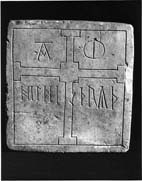Volume I: County Durham and Northumberland
Select a site alphabetically from the choices shown in the box below. Alternatively, browse sculptural examples using the Forward/Back buttons.
Chapters for this volume, along with copies of original in-text images, are available here.
Current Display: Hartlepool 01, Durham


Overview
Object type: Complete recumbent grave-marker [1]
Measurements: H. 27.9 cm (11 in); W. 29.2 cm (11.5 in); D. 14 cm (4.5 in)
Stone type: Hartlepool and Roker dolomite
Plate numbers in printed volume: Pl. 84.433
Corpus volume reference: Vol 1 p. 98
(There may be more views or larger images available for this item. Click on the thumbnail image to view.)
Present Location
Inside St Hilda's Church
Evidence for Discovery
Found July 1833 '...In digging the foundations of a house belonging to Mr John Bulmer in a field called 'Cross Close' at a distance of about 135 yards from the present church-yard and in a south-easterly direction at the depth of three feet and a half and immediately upon the limestone' ((-) 1833, 218). Associated with skeletons lying roughly north-south (ibid). Early accounts agree that flat, unornamented stones, 4 to 5 inches square, were found under the heads of some skeletons, but reports vary for the 1833 group as to whether the ornamental stones were found under ((-) 1833, 218) or over (Haigh 1846, 185) the skulls. Regarded as lost for many years. Given by builder who found it to timber merchant, whose daughter, Miss Ensor, presented it to Ipswich Museum (Scott 1956, 196). Restoration to Hartlepool recorded in (-) 1928.
Church Dedication
St Hilda
Present Condition
Unworn
Description
The stone is almost square. The sides and back are dressed smoothly.
A (broad): The one carved face is edged by a deep incised border. The face is quartered by an incised cross, type A3, with a square centre, and is inscribed:
(a) Upper quadrants:
A II Ω
The terminals of the Alpha (upper left) are seriffed. The Omega (upper right) is of the closed form (cf. no. 6).
(b) Lower quadrants, in runes:
hildi II þryþ
This gives the feminine personal name Hildithryth. The letters are deeply and confidently cut, with neat serifs, but are strangely set out so that they gradually increase in size.
Discussion
This is the only cross of this type in the Hartlepool group, but can be compared with Clonmacnois, co. Offaly (Lionard 1961, fig. 10), and Birtley 2. However, the stepped terminals of 5 and the Alpha and Omega inscription of 6 (albeit of a different form) provide other parallels within the group. (See also Discussions under 2 and 8.)
Date
Eighth century
References
(—) 1833, 219 and fig.; Gage 1836, pl. 52,3; Kemble 1840, 346, pl. 16, 12; (—) 1844; Haigh 1846, 187 and fig.; Cutts 1849, 60, pl. 3; Sharp 1851, 26-33, fig. 2; Haigh 1858, 19 and fig.; Haigh 1861, 44; Stephens 1866-7, xxvi, 392-5, fig. on 392; Greenwell and Westwood 1869; Haigh 1875, 366, no. 3, pl. 2, 1; Hübner 1876, 69, no. 189, and fig.; Stephens 1884b, 127-8, fig. on 127; Allen and Browne 1885, 352; Sweet 1885, 128; Allen 1887, 118, fig. 23; Pettigrew 1888, 27, fig. on 29; Allen 1889, 260; Bugge 1891-1903, 118, 243; Boyle 1892, 611; Hodges 1894, 6; Stephens 1894, 50-1; Viëtor 1895, 18, fig. 11; Chadwick 1901, 83; Hodges 1905, 212; Browne 1917, 142; Howorth 1917, III, 189-92, 303-4, pl. facing 188; Brown 1918-19, 201, fig. 3; Brown 1921, 64-5, fig. 3; (—) 1928; Friesen 1933, 51, 59; Arntz 1938, 76, 89; Dahl 1938, 910; Åberg 1943, 105, fig. 77; Bæksted 1943, 44; Scott 1956, 196, 200. pl. 6, 1; Elliott 1959, 71, 81-3, fig. 30; Marquardt 1961, 4951; Page 1964, 84; Page 1973, 53-4, 104, 135, 141, 143, fig. 16, pl. 1; Morris 1976, 143
Endnotes
1. The following are general references to the Hartlepool stones: Charlton 1855-7, 70-1; Haigh 1873, 269; Smith and Cheetham 1880, 1979; Stephens 1884a, 189; Allen and Browne 1885, 352; Browne 1886b; 12; Howorth 1914, 47; Peers 1914-15; Clapham 1930, 75; Rivoira 1933, 153; Pfeilstűcker 1936, 127; Kendrick 1938, 110; Henry 1965, 158; Page 1973, 25.



